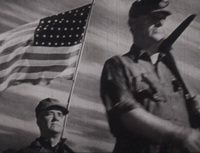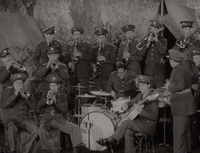Soundies and the War

Patriotic Soundies were frequent due to World War II, some were even directly sponsored or made by the U.S. government.
American involvement in World War II was an unexpected development for Soundie and Panoram production and would leave lasting impacts on the evolution of both aspects of the musical jukebox. With Soundies introduced in late 1940, the war in Europe was already ongoing, and by December of the following year the U.S. would be brought into the conflict. U.S. entrance into World War II created serious challenges for the Mills Novelty Company and its visual jukebox. Perhaps the most severe was the quickly-implemented restrictions on strategic resources to conserve raw materials for military equipment. After February of 1942 Panoram production dwindled with restrictions on aluminum, dropping initial production targets at a vital point in the adoption phase for the machine. Early, and perhaps optimistic, pre-war Panoram production targets ranged from 30,000 to 100,000 units.43 By the end of Panoram manufacturing in the late 1940s, only about 5,000 Panorams were made.44 Further, James Roosevelt, an early and outspoken advocate for Soundies and an executive in the Soundies Distributing Corporation of America, left his duties to join the war effort soon after direct U.S. involvement in the war started.45 According to Dr. Andrea Kelley, an expert on Soundies history, James Roosevelt was critical for early publicity efforts of the Panoram and Soundies, often appearing in marketing materials and interviews.46 James, or “Jimmy,” Roosevelt was commissioned as a captain in the Marines, and was significantly less active in production and marketing of Soundies even though his name would be prominent in the later creation of the Roosevelt-Coslow-Mills (RCM) company.47 American involvement in the war had serious consequences for the early expansion of Panorams and Soundies.

Soundies helped popuilarize wartime efforts, like conserving and collecting tin cans and other materials for use in war industry.
Some positives also came out of the wartime environment for the visual jukebox. The U.S. government becaame a significant purchaser of Panorams for use in the war effort. On military bases Panorams were specially outfitted to continuously loop training films on various topics to soldiers about to serve overseas. Sometimes these Panorams would be modified with a backdrop and props to give a deeper feeling of immersion to soldiers, with one prominent example resembling a “hut’ to educate soldiers on the food and vegetation within their future deployment zones. Some were even outfitted with answer functions to quiz soldiers on the materials after presentations.48 Another use of Panorams by the government was in recruitment and war bond and defense stamp drives.49 By utilizing the mobility of Panorams and the ability to make looping films free to play, the government saw increased war bond sales through the strategic placement of specially-outfit Panorams in war drive centers, high-traffic public areas (including civic centers and department stores), and at war rallies.50 In rallies and other live government sponsored events, the Panoram was used as a mobile filler, holding the attention of audiences between speakers.51 Additionally, Panorams were often purchased by private businesses and the government in connection to the wartime manufacturing boom.52 Placed near vending machines in breakrooms, these Panorams were selected to boost morale among workers before resuming their long shifts assembling critical war supplies or by soldiers in their downtime on base.53 American involvement with World War II led to many adaptations of the Panoram and new audiences never fully envisioned by its creators.
Some American sentiment was less than subtle, like the finale from "America, I Love You."
What viewers saw at their local Panorams was also influenced by the war. Patriotism, the homefront, and the war were common themes for many Soundies. Production houses and the federal government had close ties during this era. Voluntary partnerships in the areas of censoring unpatriotic materials or the creation of pro-American content were seen as ways to curry favor and to avoid forced regulation.54 The government would also directly create their own Soundies and request they be put into rotation with the rest of the available catalog. One instance of this was the publicity surrounding the Fifth War Loan Drive in which the Office of War Information created the Soundies "Semper Paratus (Coast Guard Song)," "Caissons Go Rolling Along," "Anchors Aweigh," "Marine’s Hymn," and "Keep ‘em Rolling" to encourage the public’s contribution to the funding drive.55 The reasoning for Soundie creation by the government centered around a reluctance for direct propaganda efforts as they feared the direct approach would not resonate and that a filter was needed, as the Office of War Information’s Chief Elmer Davis stated, “‘The easiest way to inject a propaganda idea into most people’s minds is to let it go through the medium of an entertainment picture when they do not realize that they are being propagandized.’”56 The number of different government agencies along with production houses and censorship boards though could make such efforts challenging.57 Whether these films and others with patriotic messages actually affected morale and support for the war are likely indeterminable.




